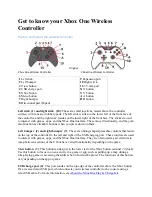
Page 6
Similarly, you can type the lowercase letter “k” by pressing and releasing (with your index
finger) the left key in the top row, no keys in the next two rows, and (with your little finger)
the right key in the bottom row. This chord is designated by the notation LOOR. OOR is the
notation for typ ing the letter “k”.
Labels
Black, red, blue, and green labels on Twiddler’s keys can remind you how to type the most
common characters and commands.
A white label on a key refers to the character or command you type when you press and
release that key alone. To type a lowercase “a”, you press and release the key labeled
with a white “A”. To type a lower case “b”, press and release the key labeled “B”; and so
on for keys labeled C, D, E, F, G, and H. Similarly, keys marked SP (space), DEL (delete), BS,
(backspace), and ENT (enter) issue the designated command when pressed and released
singly.
You will find a colored dot above each top row key. Red marks the top left key; blue
marks the top middle key; and green marks the top right key. To the right of each key in
the remaining three rows you will find a column of three labels whose colors-red, blue,
and green-correspond with the colors of the top row dots. Matching colors indicate a
dotted-key/labeled-key chord which types the labeled character.
FINGER KEYS
are indicated by a group of four symbols: 0, L, M,
and R.
These symbols repre sent key presses in ROWS 1, 2,3, and 4 (top to
bottom). 0 means no button pressed in that row; L means the Left
button is pressed; M means the Middle button is pressed; and, R
means the Right button is pressed.
Example: LOOR means the LEFT Button in ROW 1 and the RIGHT
button in ROW 4 are pressed. No buttons are pressed in ROW 2 or
ROW 3.
This example types the letter k.































